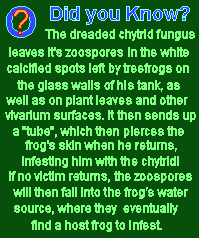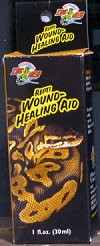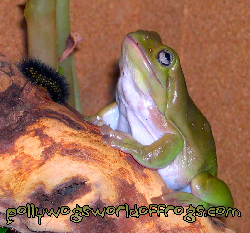Fungal Infections
 Fungal infections are common in amphibians and are often secondary to stress,
trauma or other immunosuppressive factors.
(Try boosting your frog's Immune system yourself).
Fungal infections are common in amphibians and are often secondary to stress,
trauma or other immunosuppressive factors.
(Try boosting your frog's Immune system yourself).
Some fungal organisms are primary pathogens and others can be isolated/removed from healthy animals without evident lesions or scarring.
Granulomas or abscesses may be found in any organ. Skin ulcers and nodules are also common. Superficial lesions can be treated with topical antiseptics or fungicides. Systemic infections may require sulfadiazine or imidazoles. Beware though, Infection tends to re-occur once therapy is completed. In aquatic species, Saprolegnia and other aquatic fungal infections may develop on wounds or on bacterial ulcers. There are some common medications used for fish at the Pet Shop. Jungle makes a very good line of antifungals.
Read on below to find lists of particular fungal infections known to be found in frogs.
Chytridiomycosis
Pronounced 'KIT-rid-ee-o-my-co-sis'
 Batrachochytrium dendrobatis is a stringy microscopic fungus
that can be found in the dung of amphibians, reptiles,
and insectivorous bats, as well as wood lice, plant debris and soil.
Batrachochytrium dendrobatis is a stringy microscopic fungus
that can be found in the dung of amphibians, reptiles,
and insectivorous bats, as well as wood lice, plant debris and soil.
The origin of chytrid is worldwide. They start in soil and water as sacrophytes, degrading substances such as chitin, plant detritus and keratin. After a frog eats an insect that has been in said infested soil, the sacrophytes move to the next stage of their development, zoospores. Using the frog as a host, they multiply and in all cases so far, kill the frog within 10 to 18 days after infection.
It has been seen in almost every genus of frog, land-based or aquatic, and is epedemic in the frog community, thought to be responsible for the possible extinction of many species.
SymptomsIt causes signs similar to those of bacterial septicemia, Tissues in the frog's liver, spleen, kidneys, and heart can also begin to die off in patches.
 Also called the "absent righting reflex disease" as the frog may have lost his
ability to flip back over from its' back. Abnormal posture such as back legs
spread out. Shows
hyperpigmentation,
skin-sloughing, loss of slime layer and floating near surface. Diurnals may sleep in day,
Nocturnals awake in day. Thickened skin and sudden death.
Highly contagious to your other frogs!
Also called the "absent righting reflex disease" as the frog may have lost his
ability to flip back over from its' back. Abnormal posture such as back legs
spread out. Shows
hyperpigmentation,
skin-sloughing, loss of slime layer and floating near surface. Diurnals may sleep in day,
Nocturnals awake in day. Thickened skin and sudden death.
Highly contagious to your other frogs!
Update!
Steve Busch has some interesting news on treating this ailment: click this link to learn a brand new treatment for chytrid: Chytrid treatment
Prevention is a must do when worrying about chytrid. Proper sterilization, use of disposable gloves between tanks, frequent hand-washing, 90 day quarantine of new pets and other practices of good anuran husbandry will go a long way towards prevention of an outbreak in your frog colonies. Since they are mainly soil-borne, you may want to consider not using soil in your plantings. See method used for this on the Vivarium page. I personally like the use of Scott's fine peat moss, and do use soil in my tanks, but it is up to you to decide how far you want to take prevention. Without further testing (peat has low ph) I'm unable to tell you if peat use does remand the fungus. I'll update this when I'm sure. Also be cautious with their food sources, which have come in contact with other breeders, soil, etc.
From Steve's post link above, if I were you, I would treat all frogs you have in your collection whether or not you think they have it, as the cure is harmless. The link I gave you above is so important that you read. Here's another if you're new to chytrid: More on Chytrid
September, 2010, article on what our government is thinking about doing to protect our natural frog populations from this deady fungus: frogsaregreen.com
 If you're a keeper of treefrogs, you may notice that your frogs will
prefer a certain large leaf or one particular spot on the glass tank
in which to curl up for his resting period. After some time, you may
begin to see what is called a "drink-patch" (sometimes
called a
If you're a keeper of treefrogs, you may notice that your frogs will
prefer a certain large leaf or one particular spot on the glass tank
in which to curl up for his resting period. After some time, you may
begin to see what is called a "drink-patch" (sometimes
called a 
 seat-patch) on the glass when
the frog leaves it. This is a hard, white area about the size of the frog's
belly. It contains minerals like calcium and other chemicals that the frog has,
through osmosis; "respirated". It can only be removed through
use of a razorblade or weak acids that can change the PH. By the way, use of
a razorblade would only microscopically "spray" the zoospores throughout the tank!
seat-patch) on the glass when
the frog leaves it. This is a hard, white area about the size of the frog's
belly. It contains minerals like calcium and other chemicals that the frog has,
through osmosis; "respirated". It can only be removed through
use of a razorblade or weak acids that can change the PH. By the way, use of
a razorblade would only microscopically "spray" the zoospores throughout the tank!
 But I'm getting ahead of myself. This white calcified patch becomes a breeding ground for
the chytrid zoospores. They nestle in the drink-patch and await the arrival of the
unwary frog to return to his favorite nitch. When the fungi senses the presense of the frog,
it sends out a spiracle, or "tube" that pierces the frog and infects him!
(So much reminding me of the scene in the egg-chamber room in the original Alien movie,
but this one's real ! )
But I'm getting ahead of myself. This white calcified patch becomes a breeding ground for
the chytrid zoospores. They nestle in the drink-patch and await the arrival of the
unwary frog to return to his favorite nitch. When the fungi senses the presense of the frog,
it sends out a spiracle, or "tube" that pierces the frog and infects him!
(So much reminding me of the scene in the egg-chamber room in the original Alien movie,
but this one's real ! )
Unlike the eggs in Alien, the chytrid fungi zoospores have a back-up plan. If no frog returns to the drink-patch or leaf within a certain time, they simply release themselves into the water in the vivarium, where they will be able to infect all of the frogs anyway!
This would give a good frogger strong reason then; to prevent these build-ups in the first place! Therefore, use of the proper sterilizing methods for the tank through thorough rinsing in said sterilization mix is a must, one that should be used monthly in an established community, and once weekly in a quarantine tank with new inhabitants. To see the recipe for such, Click Here.
If you suspect that your frog has indeed been infected with the chytridiomycosis fungi, try Steve's treatment above and use all sterilization methods mentioned on the Quarantine page.
Afternote: Major Brianna Lam of the James Madison University has found that the naturally occurring bacteria, pedobacter cryoconitis may actually help protect wild species of amphibians against chytridomycosis. Read more about it at Science Daily news
Broken Skin lesions
 The symptoms are self-explanatory. Unless the lesions are very bad, the tea-treatment
(see "General Scrapes" below)
will do the trick. For deeper, more serious lesions, try the sulfameter or tetracycline
treatment. For all treatments, use the Heat Treatment schedule.
Remember though; broken skin that is not
treated immediately can turn into a much more serious dilemna-it is an "open door" to various
fungi and bacteria just waiting to get into your frog and assault his system.
The symptoms are self-explanatory. Unless the lesions are very bad, the tea-treatment
(see "General Scrapes" below)
will do the trick. For deeper, more serious lesions, try the sulfameter or tetracycline
treatment. For all treatments, use the Heat Treatment schedule.
Remember though; broken skin that is not
treated immediately can turn into a much more serious dilemna-it is an "open door" to various
fungi and bacteria just waiting to get into your frog and assault his system.
Another point to remember, unless you know the wound was made from a mishap with sharp stone, a plant, or another aggressive frog, consider the lesion may in fact be the sign of an internal problem that has finally erupted to the surface. This type of lesion will usually have a different look to it, such as puss-like edges and a deeper core center to the wound. Knowing the difference between the two can save you time searching for a cure, and possibly save the others who live with the afflicted frog.
General Scrapes The use of Camomile tea that you have brewed in distilled water, weakened slightly and
let cool completely can then be placed in a plastic eyedropper. Drop a couple of drops on the
wound. Keep a close eye on the wound, and repeat as necessary. Look
for a complete shedding of skin.
The use of Camomile tea that you have brewed in distilled water, weakened slightly and
let cool completely can then be placed in a plastic eyedropper. Drop a couple of drops on the
wound. Keep a close eye on the wound, and repeat as necessary. Look
for a complete shedding of skin.
If the wound does not heal up within 10 days, consider it to be a more serious problem, perhaps internal.
Wound-healing aids are also available, made directly for the purpose of herps. Zoo Med makes one such aid called "Repti Wound Healing Aid".
Sulfameter may be used in more intense cases, and medically is called a sulfonamide, but may not be readily available. You can try keywording it and see if a search engine can find an outlet for you, but unless the wounds are extensive, the camomile tea alone should do the trick. TriSulfa, made by Mardel labs, can be used if you can't locate any sulfameter.
Crush approx. 1/4 tablet into 1 quart of distilled water. Shake well, then let settle. Place medicated water into a clean glass jar. Fill an eyedropper with the liquid, then gently place a few drops onto the frogs' wound. Observe the frog over the next week or so, and only re-treat as needed. Frog skin is delicate and over treating might risk "burning" his skin. Keep an extra eye on the little fellow next time he sheds, you want to see a complete skin. If after 10 days there is not much improvement, look towards a more serious implication.
 Deeper Wounds
Deeper Wounds
Move the frog to a hospital tank for this treatment. A bit more intense. Use the heat treatment listed below. Place 1 capsule tetracycline powder in one cup of distilled water. (Those are 250mg capsules) Mix well, place in clean glass jar. Use an eyedropper to place a few drops of the liquid onto the wound, repeat daily for 3 days.
After 4 days, terminate the heat treatment, and if needed, continue with the antibiotic treatment for up to 2 more days. Look for a complete skin-shed before returning him to the main tank. (For more on skin-shedding, Click Here.
While the affected frog is being given treatment, sterilize the main tank.
Eye Problems
Frogs can often develop eye problems. Because most enjoy a moist environment, they are susceptible to an array of various maladies in this arena. Clouded lenses and/or bulging eyes are two of the more common problems seen.
First remove the frog to a Hospital tank. Now check the main vivarium for anything that could have caused the situation, such as a sharp stone, a bromeliad with spines, or some other sharp object. Remove it! Even if it is not the problem, this could potentially prevent problems in the future.
Now back to sick froggy. Open a teramycin capsule (You can use one intended for fish, available at pet shop). Take just a pinch and place in 1/4 cup of distilled water. Stir it very well. Take a plastic eyedropper and suck up two or three drops. Then place the drop or so in the infected eye(s) of frog. Repeat this treatment once daily for 6-8 days, same time daily. After the treatment is over, leave frog in Hospital tank another week to observe and make sure the eye remains clear.
Incidentally, throw out the leftover teramycin water after every treatment. Make a fresh batch every day, and sterilize the eyedropper you have used. This will stop any cross/re-infection.
Clouded Eyes
Frogs eyes may at some time cloud over. This is usually caused by a bacteria called chryseobacterium. It will live for some time with the frog and show no signs of it's presence. However, after it does begin to affect the frog, it's not a pretty picture. It will attack the frogs lymph node system and weaken it. Lymph glands are part of any animals'immune system that help it to fight off infection and disease.
Seperate the frog to a hospital tank. Use methelene blue as eyedrops. Do not weaken the solution. Do this twice a day for 3 days. Spray a 5% solution of Baytril mixed with distilled water on the frog before using the methelene blue. After the 3 days are up, you should see marked improvement, and be able to return the frog to his normal quarters.


